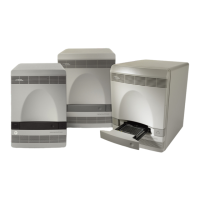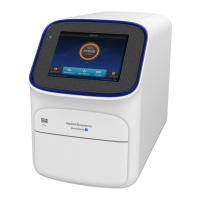DRAFT
September 25, 2007 1:07 am, 4376782_Preface.fm
Preface
Chemical Waste Safety
xvii
Applied Biosystems StepOne
™
and StepOnePlus
™
Real-Time PCR Systems
Installation, Networking, and Maintenance Guide
Chemical Waste Safety
Chemical Waste
Hazard
HAZARDOUS WASTE.
Refer to Material Safety Data Sheets and local
regulations for handling and disposal.
CHEMICAL WASTE HAZARD.
Wastes produced by Applied
Biosystems instruments are potentially hazardous and can cause injury, illness, or death.
CHEMICAL STORAGE HAZARD.
Never collect or store waste in a
glass container because of the risk of breaking or shattering. Reagent and waste bottles can
crack and leak. Each waste bottle should be secured in a low-density polyethylene safety
container with the cover fastened and the handles locked in the upright position. Wear
appropriate eyewear, clothing, and gloves when handling reagent and waste bottles.
Chemical Waste
Safety Guidelines
To minimize the hazards of chemical waste:
• Read and understand the Material Safety Data Sheets (MSDSs) provided by the
manufacturers of the chemicals in the waste container before you store, handle, or
dispose of chemical waste.
• Provide primary and secondary waste containers. (A primary waste container holds the
immediate waste. A secondary container contains spills or leaks from the primary
container. Both containers must be compatible with the waste material and meet federal,
state, and local requirements for container storage.)
• Minimize contact with chemicals. Wear appropriate personal protective equipment when
handling chemicals (for example, safety glasses, gloves, or protective clothing). For
additional safety guidelines, consult the MSDS.
• Minimize the inhalation of chemicals. Do not leave chemical containers open. Use only
with adequate ventilation (for example, fume hood). For additional safety guidelines,
consult the MSDS.
• Handle chemical wastes in a fume hood.
• After emptying a waste container, seal it with the cap provided.
• Dispose of the contents of the waste tray and waste bottle in accordance with good
laboratory practices and local, state/provincial, or national environmental and health
regulations.
Waste Disposal
If potentially hazardous waste is generated when you operate the instrument, you must:
• Characterize (by analysis if necessary) the waste generated by the particular
applications, reagents, and substrates used in your laboratory.
• Ensure the health and safety of all personnel in your laboratory.
• Ensure that the instrument waste is stored, transferred, transported, and disposed of
according to all local, state/provincial, and/or national regulations.
IMPORTANT!
Radioactive or biohazardous materials may require special handling, and
disposal limitations may apply.
